Installation Guide
3. Connect devices to the switch.
We recommend using the following SFP modules or cables:
• For 10G ber connectivity:
- SFP modules: NETGEAR AXM761, AXM762, or AXM764
- Cables: NETGEAR AXC761 (1 m), AXC763 (3 m), AXC765 (5 m),
AXC767 (7 m), AXC7610 (10 m), AXC7615 (15 m), or AXC7620 (20 m)
• For 40G ber connectivity:
- SFP modules: NETGEAR AXLM761 or AXLM762
- Cables: NETGEAR AXLC761 (1m) or AXLC763 (3m)
• For 100G ber connectivity:
- SFP modules: NETGEAR ACM761 or ACM762
- Cables: NETGEAR ACC761 (1m) or ACC763 (3m)
Note: The QSFP28 ports on models M4500-48XF8C and M4500-32C are
precongured for 100G speed. If you want to use a 40G SFP module in a QSFP28
port, you rst must congure the port for 40G speed. The SFP28 ports on model
M4500-48XF8C are precongured for 10G speed.
Note: If purchased, SFP modules and cables are shipped separately. For more
information about installing an SFP module, see the hardware installation guide.
2. Congure the IP address of the switch
You can access the switch through its console port, its out-of-band (OOB) port
(which is also referred to as the service port), or through an Ethernet network
port (which is also referred to as the management interface).
To congure the IP address of the switch, use one of the following methods:
• CLI. Use the command-line interface (CLI) through the RJ-45 RS232 console
port to congure the IP address manually (see Use the CLI to congure the IP
address).
• DHCP server. Connect a DHCP server through an OOB port or through
any Ethernet network port and nd the assigned IP address (see Find the IP
address assigned by the DHCP server).
After you congure or nd the IP address of the switch, you can congure the
features of the switch through the CLI.
M4500 Intelligent Fully Managed Switches
M4500-32C and M4500-48XF8C
1. Set up the switch
Prepare the installation site so that mounting, access, power source, and
environmental requirements are met. For more information about these
requirements, see the hardware installation guide, which you can download by
visiting netgear.com/support/download/.
1. Install the switch using one of the following methods:
• On a at surface. Place the switch on a at surface.
• In a rack. Use the rack-mount kit that is supplied with your switch,
following the installation instructions in the hardware installation guide.
2. Apply AC power.
The Power LED lights solid yellow while the switch conducts a power-on
self-test (POST). After the switch passes the POST, the Power LED lights solid
green, and the switch is functional. If the Power LED does not light green, see
the following information:
• If the Power LED remains solid yellow, the POST failed. For more
information, see the hardware installation guide.
• If the Power LED does not light at all, check to see that the power cable
is plugged in correctly and that the power source is functioning. If this
action does not resolve the problem, see the hardware installation guide
for more information.
Use the CLI to congure the IP address
To use the CLI for initial conguration and assign a static or dynamic IP address
to the switch, connect a computer or VT100/ANSI terminal to one of the console
ports on the switch.
1. Connect one end of the console cable that is included in the product
package to the RJ-45 RS232 console port on the switch and connect the
other end to your computer or terminal.
2. If you connect a computer to a console port on the switch, start a terminal
emulation program:
• On a computer with a Windows operating system, you can use
HyperTerminal or Tera Term.
• On a computer with a Mac operating system, you can use ZTerm.
• On a computer with a Linux operating system, you can use TIP.
3. If you connect a computer to the console port on the switch, congure
the terminal emulation program to use the following settings: baud rate,
115,200bps; data bits, 8; parity, none; stop bit, 1; ow control, none.
4. At the user prompt, log in to the switch using the user name admin and
press Enter.
5. At the password prompt, do not type a password but press Enter.
You do not need to type a password for initial access.
6. Set up a password for the user name admin, as prompted by the CLI.
The password requires eight or more characters.
7. Log in again using the user name admin and your new password.
Note: For more information, see the software administration and
conguration guide, which you can download by visiting
netgear.com/support/download/.
You can now use the CLI to manually congure the following settings:
• Option 1. Congure the IP address for access over the service port
• Option 2. Congure the switch as a DHCP client for access over the
service port
• Option 3. Congure the switch IP address for access over an Ethernet port
• Option 4. Congure the switch as a DHCP client for access over an
Ethernet port
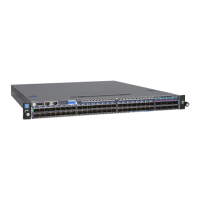

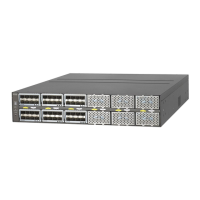

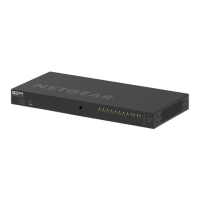
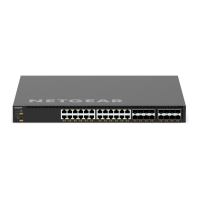
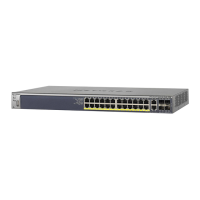



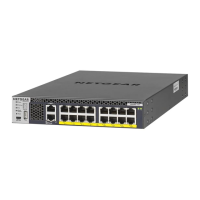
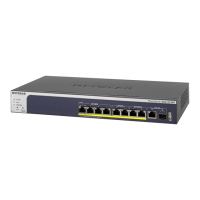
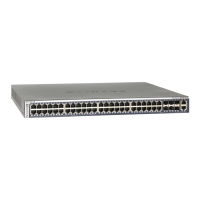
